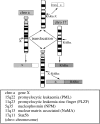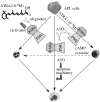Treatment of acute promyelocytic leukaemia with all-trans retinoic acid and arsenic trioxide: a paradigm of synergistic molecular targeting therapy
- PMID: 17317642
- PMCID: PMC2435563
- DOI: 10.1098/rstb.2007.2026
Treatment of acute promyelocytic leukaemia with all-trans retinoic acid and arsenic trioxide: a paradigm of synergistic molecular targeting therapy
Abstract
To turn a disease from highly fatal to highly curable is extremely difficult, especially when the disease is a type of cancer. However, we can gain some insight into how this can be done by looking back over the 50-year history of taming acute promyelocytic leukaemia (APL). APL is the M3 type of acute myeloid leukaemia characterized by an accumulation of abnormal promyelocytes in bone marrow, a severe bleeding tendency and the presence of the chromosomal translocation t(15;17) or variants. APL was considered the most fatal type of acute leukaemia five decades ago and the treatment of APL was a nightmare for physicians. Great efforts have been made by scientists worldwide to conquer this disease. The first use of chemotherapy (CT) was unsuccessful due to lack of supportive care and cytotoxic-agent-related exacerbated coagulopathy. The first breakthrough came from the use of anthracyclines which improved the complete remission (CR) rate, though the 5-year overall survival could only be attained in a small proportion of patients. A rational and intriguing hypothesis, to induce differentiation of APL cells rather than killing them, was raised in the 1970s. Laudably, the use of all-trans retinoic acid (ATRA) in treating APL resulted in terminal differentiation of APL cells and a 90-95% CR rate of patients, turning differentiation therapy in cancer treatment from hypothesis to practice. The combination of ATRA with CT further improved the 5-year overall survival. When arsenic trioxide (ATO) was used to treat relapsed APL not only the patients but also the ancient drug were revived. ATO exerts dose-dependent dual effects on APL cells: at low concentration, ATO induces partial differentiation, while at relatively high concentration, it triggers apoptosis. Of note, both ATRA and ATO trigger catabolism of the PML-RARalpha fusion protein which is the key player in APL leukaemogenesis generated from t(15;17), targeting the RARalpha (retinoic acid receptor alpha) or promyelocytic leukaemia (PML) moieties, respectively. Hence, in treating APL both ATRA and ATO represent paradigms for molecularly targeted therapy. At molecular level, ATRA and ATO synergistically modulate multiple downstream pathways/cascades. Strikingly, a clearance of PML-RARalpha transcript in an earlier and more thorough manner, and a higher quality remission and survival in newly diagnosed APL are achieved when ATRA is combined with ATO, as compared to either monotherapy, making APL a curable disease. Thus, the story of APL can serve as a model for the development of curative approaches for disease; it suggests that molecularly synergistic targeted therapies are powerful tools in cancer, and dissection of disease pathogenesis or anatomy of the cancer genome is critical in developing molecular target-based therapies.
Figures



References
-
- Altucci L, Rossin A, Raffelsberger W, Reitmair A, Chomienne C, Gronemeyer H. Retinoic acid-induced apoptosis in leukemia cells is mediated by paracrine action of tumor-selective death ligand trail. Nat. Med. 2001;7:680–686. doi:10.1038/89050 - DOI - PubMed
-
- Arnould C, Philippe C, Bourdon V, Gregoire M.J, Berger R, Jonveaux P. The signal transducer and activator of transcription STAT5b gene is a new partner of retinoic acid receptor alpha in acute promyelocytic-like leukaemia. Hum. Mol. Genet. 1999;8:1741–1749. doi:10.1093/hmg/8.9.1741 - DOI - PubMed
-
- Bennett J.M, Catovsky D, Daniel M.T, Flandrin G, Galton D.A, Gralnick H.R, Sultan C. Proposals for the classification of the acute leukaemias. French–American–British (FAB) cooperative group. Br. J. Haematol. 1976;33:451–458. - PubMed
-
- Bennett J.M, Catovsky D, Daniel M.T, Flandrin G, Galton D.A, Gralnick H.R, Sultan C. A variant form of hypergranular promyelocytic leukaemia (M3) Br. J. Haematol. 1980;44:169–170. - PubMed
Publication types
MeSH terms
Substances
LinkOut - more resources
Full Text Sources
Other Literature Sources
